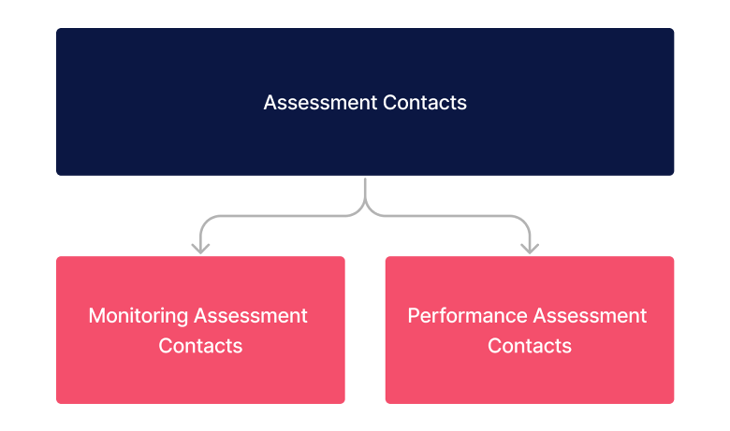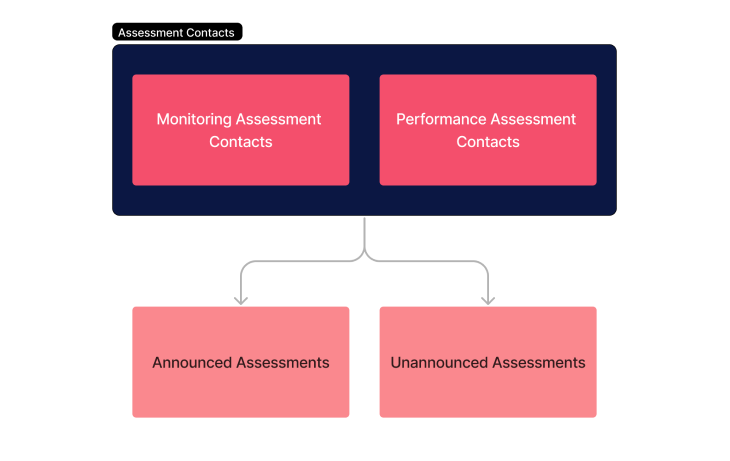This article is a simplified guide for managers, L&D practitioners, and educators in aged care about the compliance ratings used by the Aged Care Qaulity and Safety Commission. View the ACQSC assessment contacts in residential and home services information here.
What are Assessment Contacts as Part of the ACQSC?
Assessment contacts play a pivotal role within the regulatory framework of the Aged Care Quality and Safety Commission. They serve as a means to monitor the quality of care and services delivered by aged care service providers. The Commission follows a risk-based and proportionate approach in determining when and for what purposes assessment contacts should be conducted.
Assessment contacts are considered any form of contact other than a site audit, review audit, or quality review between a regulatory official and the service provider.
What are the Types of Contact Visits?
The Aged Care Quality and Safety Commission Rules 2018 define assessment contact as any form of contact, excluding site audits, review audits, or quality reviews, between a regulatory official and the service provider.

The types of contact visits are:
- Monitoring assessment contacts - This refers to an assessment contact conducted for the purpose of monitoring the quality of care and services provided by the service provider.
- Performance assessment contacts - This type of assessment contact aims to assess the provider's performance in relation to the service against the Quality Standards.
Assessment contacts, especially those focused on performance assessment, typically target specific Quality Standards based on identified risks. Assessment contacts for monitoring, on the other hand, are information-gathering exercises that may inform the need for a performance assessment in the future.
Who Performs Assessment Contacts?
An assessment team comprising one or more quality assessors, the assessment team is responsible for conducting the assessment contact.
Why are Assessment Contacts Performed?
Assessment contacts are vital activities undertaken by the Commission to ensure the quality of care and services delivered by aged care service providers.
The Commission conducts assessment contacts for several critical reasons:
- Assessing Provider Performance against Quality Standards: One primary aim is to evaluate how well the provider performs concerning the service in relation to the Quality Standards. This may be prompted by past instances of non-compliance with these standards or when regulatory intelligence, such as complaints or risk reports, suggests potential harm to consumers or issues with care quality.
- Monitoring Care Quality Delivered by Providers: Assessment contacts are also conducted to monitor the ongoing quality of care and services provided through the service. This can be triggered by previous performance assessments that have identified areas for improvement to ensure compliance with Quality Standards. Other factors include regulatory intelligence, structured consumer experience interviews and reports, regulatory campaigns targeting systemic risks, changes in compliance expectations, or the need to inform providers and consumers about key care quality issues at meetings.
Where are Assessment Contact Visits Performed?
The Commission Rules outline provisions for informing aged care consumers and their representatives about assessment contacts. This is dependent on the risk profile of the service, as well as the reason for the assessment contact.
This can take the form of on-site visits, requests for information or documents, and reporting on the assessment contact.
| Contact Type | Description |
|---|---|
| Visit to Service | When necessary information for monitoring is best obtained through an on-site visit. For example, if a Notice to Remedy has been issued, a quality assessor visits the service's premises to assess compliance with Quality Standards. |
| Phone or Email Contact | When required information can be obtained without a physical visit, or when travel restrictions or other reasons make a visit impossible. This contact can be used to review progress against improvement plans or discuss regulatory changes. |
| Management or Board Meeting | Attendance at management or board meetings to gather information, discuss requirements, or address key issues related to the service. |
| Assessment of Previously Accredited Service | The Commission can conduct assessment contacts with providers of previously accredited services, even if accreditation has been revoked. This allows monitoring of care and services delivery by providers still offering care through the service. |
| Assessment Across Multiple Services | The Commission can assess a provider's performance against Quality Standards or monitor care and services across all their home and residential services through a single assessment contact. For example, assessing organisational governance across all services. |
How Does the ACQSC Determine When an Assessment Contact Should Occur?
The Commission maintains a flexible approach to conducting assessment contacts, which can occur beyond standard business hours and even on weekends. This flexibility is crucial for accommodating the unique needs of each service provider.
When deciding on the specifics of an assessment contact, the Commissioner takes into account the individual circumstances of the service and relevant information. This personalised approach ensures that the assessment contact is well-suited to the provider's situation.
In determining the arrangements for an assessment contact, the Commissioner considers several key elements:
- Purpose of the Assessment Contact: This includes identifying the specific objectives or goals of the assessment contact.
- Type of Contact: The Commissioner determines whether the assessment contact will be conducted through a site visit, a meeting, or a phone call.
- Timeframe: The timeframe for completing the assessment contact is established, ensuring efficient and timely assessments.
- Scope: The scope of the assessment contact is defined, outlining the areas or aspects that will be assessed.
How Are (Approved) Providers Notified of Assessment Contacts?
Assessment contacts can be categorised into announced and unannounced assessments. These approaches offer flexibility and serve distinct purposes in ensuring compliance with Quality Standards.

Announced Asssessment Contacts
Announced assessment contacts involve prior notice provided to the service provider, either in written or verbal form. This notification includes details about the assessment contact, such as its purpose, the format it will take, and, where possible, its scope.
Unannounced Assessment Contacts
In contrast, unannounced assessment contacts occur without any prior notice to the service provider. They are crucial for assessing the provider's performance in relation to the service against the Quality Standards. This lack of notice ensures that assessments are conducted without any preparation by the service provider.
The Commissioner may initiate unannounced assessments for several reasons:
- In Response to Complaints or Compulsory Reporting: When the Commission receives complaints or mandatory reporting information, unannounced assessments may be conducted to address concerns promptly.
- Addressing Gaps in Systems: Unannounced assessments may follow up on gaps in systems and processes identified during previous performance assessments.
- Supporting Regulatory Campaigns: Unannounced assessments support regulatory campaigns aimed at addressing systemic risks prevalent in the sector.
- Responding to Non-Compliance Trends: Increasing non-compliance in services operated by the same provider may trigger unannounced assessments to ensure compliance with Quality Standards.
What Documents Can Be Requested for Assessment Contacts?
In the context of assessment contacts within aged care, it's important to know what documents may be requested. Here's a summary of the document request process and the types of documents involved:
- Key Documents for Accredited Services (Performance Assessment) - These documents aid the assessment team in understanding the aged care service and identifying consumers and staff to engage with. They are typically requested at the start of the visit and during the entry meeting. Providers are expected to provide them within one hour of the meeting's conclusion.
- Requests Beyond On-Site Visits - Documents may be requested via email (such as submitting self-assessment information or a plan for continuous improvement). This information is vital for assessing the provider's performance in relation to the service against the Quality Standards. Providers are obliged to provide this requested information promptly.
How Does the Commission Determine the Scope of an Assessment Contact?
The scope of a performance assessment contact in aged care is a critical aspect that ensures the evaluation of compliance with Quality Standards. Here's a concise overview:
- Commissioner's Pre-Assessment Scope Determination - Before conducting a performance assessment contact, the Commissioner defines its scope. This determination is based on regulatory intelligence or prior instances of non-compliance identified during earlier assessments.
- Notification of Scope in Announced Assessment Contacts - For announced assessment contacts, providers are typically informed about the predetermined scope. This transparency allows providers to prepare accordingly.
- Flexibility in Scope Adjustments - During the assessment contact, the assessment team has the flexibility to adjust the scope or include additional Quality Standards for assessment. This adjustment can arise from feedback received from consumers or their representatives or from emerging evidence suggesting potential non-compliance with Quality Standards.
- Communication with the Commission - In the event of a change in scope, the assessment team communicates with the Commission to discuss the reasons behind the alteration. This ensures transparency and alignment with assessment objectives.
What Happens After an Assessment Contact?
Reporting performance assessments is a crucial part of maintaining transparency and quality in aged care. Here's a summary of how this process works:
| Step | Description |
|---|---|
| Assessment Contact Report | After each performance assessment contact, the Assessment Team compiles an assessment contact report about the service. This report is submitted to the Commission within seven days of completing the assessment contact. It evaluates performance against Quality Standards, categorising it as "Not Met" or "Met" at the Standard and requirement levels where applicable. |
| Provider's Opportunity to Respond | The Commission shares the assessment contact report with the service provider. This allows providers to understand the reasons, evidence, and facts used by the delegate in identifying areas for improvement and making compliance decisions. Providers have 14 days to provide a written response to the report. |
| Performance Report | Within 28 days of receiving the assessment contact report, a delegate of the Commissioner prepares a performance report. This report considers the assessment contact report, provider responses, and other relevant information. It assesses the provider's performance against Quality Standards, indicating compliance or non-compliance at each assessed Standard and requirement level where applicable. The report may specify areas requiring improvement for compliance and include other pertinent matters. The performance report helps distinguish between the Assessment Team's report and the final report developed by the Commissioner. |
| Provider's Receipt of Performance Report | Providers receive a copy of the performance report, which enables them to understand the findings and assessment outcomes. |
| Regulatory Response | The delegate then takes a risk-based and proportionate approach to determine the regulatory response to any non-compliance identified. This response may involve further actions like review audits or quality reviews if non-compliance persists. |
This streamlined process ensures transparency, compliance, and continual quality improvement in the aged care sector.
Need a system to support meeting compliance requirements in aged care?
Contact Ausmed today and see how we can support your aged care organisation today!
Related Resources
- How does the ACQSC identify, assess, and determine compliance?
- How Does the ACQSC Respond To and Manage Compliance?
- The Aged Care Compliance Ratings Explained (ACQSC)
Conclusion
In conclusion, the Aged Care Quality and Safety Commission, as outlined in this conversation, employs a structured and transparent approach to monitor and assess the quality of aged care services in Australia. This involves various types of assessment contacts, document requests, reporting mechanisms, and regulatory responses. These measures collectively contribute to ensuring compliance with Quality Standards, improving care quality, and maintaining public confidence in the aged care sector.
References
- Aged Care Quality and Safety Commission, ‘RB 2020-09 Assessment contacts in residential and home services’, https://www.agedcarequality.gov.au



